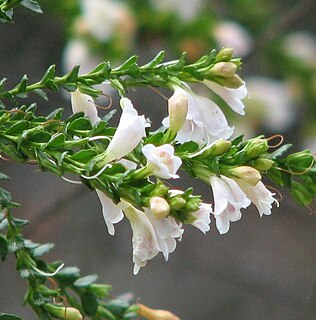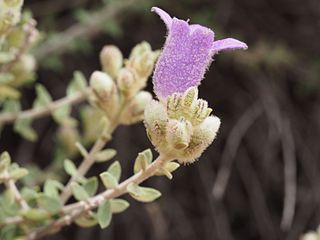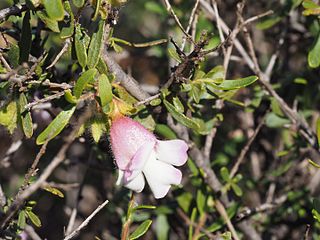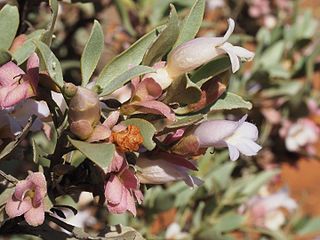
Eremophila dichroantha, also known as bale-hook eremophila, is a flowering plant in the figwort family, Scrophulariaceae and is endemic to the south-west of Western Australia. It is a shrub with many ascending branches making the plant appear broom-like. It has small, hooked leaves and small, though abundant, violet to lilac-coloured flowers.

Eremophila brevifolia, also known as spotted eremophila, is a flowering plant in the figwort family, Scrophulariaceae and is endemic to the south-west of Western Australia. It is an erect, open, spindly shrub with sticky, short, serrated leaves and white to pink flowers and is only known from a few scattered populations.

Eremophila lactea, commonly known as milky emu bush, is a flowering plant in the figwort family, Scrophulariaceae and is endemic to Western Australia. It is an erect shrub with its branches and leaves mostly glabrous but with white blotches due to the presence of dry resin. It is a critically endangered plant species mostly found in disturbed areas such as roadsides.
Eremophila ciliata, commonly known as Archer's eremophila is a flowering plant in the figwort family, Scrophulariaceae and is endemic to a small area in the south of Western Australia. It is an erect, spreading shrub with short, thick leaves and small lilac to mauve flowers. It is only known from a population of about 100 plants.

Eremophila citrina is a flowering plant in the figwort family, Scrophulariaceae and is endemic to the centre of Western Australia. It is a dense, rounded shrub with yellow new growth, crowded leaves and lilac-coloured to light purple flowers.
Eremophila coacta is a flowering plant in the figwort family, Scrophulariaceae and is endemic to a small area in the north west of Western Australia. It is an erect shrub with narrow, sticky, pointed leaves and densely hairy light to dark lilac-coloured flowers.

Eremophila densifolia is a flowering plant in the figwort family, Scrophulariaceae and is endemic to the south-west of Western Australia. It is usually a low, spreading shrub with densely clustered leaves and lilac to purple flowers.

Eremophila glutinosa, commonly known as sticky emu bush, is a flowering plant in the figwort family, Scrophulariaceae and is endemic to Western Australia. It is an erect, densely foliaged shrub with branches and leaves sticky and shiny due to the presence of resin. It has hairy sepals and lilac-coloured flowers.

Eremophila lanceolata is a flowering plant in the figwort family, Scrophulariaceae and is endemic to Western Australia. It is a low, spreading shrub with foliage which is shiny when young, angular branches and lilac to purple flowers and which grows in the north-west of Western Australia.

Eremophila malacoides, commonly known as frontage poverty bush, is a flowering plant in the figwort family, Scrophulariaceae and is endemic to Western Australia. It is a shrub with grey-green foliage, densely hairy leaves, and usually lilac to purple flowers but a yellow flowered form also occurs.

Eremophila obovata is a flowering plant in the figwort family, Scrophulariaceae and is endemic to Australia. It is a low, compact shrub with lilac to purple flowers growing mainly in the Northern Territory and Queensland but also Western Australia, South Australia and New South Wales.

Eremophila ovata is a flowering plant in the figwort family, Scrophulariaceae and is endemic to the Northern Territory. It is a small, spreading, rounded shrub with hairy branches and leaves and pink or purple flowers which are white inside.
Eremophila pallida is a flowering plant in the figwort family, Scrophulariaceae and is endemic to Western Australia. It is a small, spreading shrub with hairy stems, leaves with a few serrations and reddish purple to violet flowers.
Eremophila papillata is a flowering plant in the figwort family, Scrophulariaceae and is endemic to Western Australia. It is an erect, compact shrub with sticky, narrow leaves and mauve, blue or purple, rarely white flowers.
Eremophila phillipsii is a flowering plant in the figwort family, Scrophulariaceae and is endemic to Western Australia. It is a tall, erect, open shrub, with narrow leaves and lilac to purple flowers which are white with purple spots inside. It often has an offensive smell.

Eremophila recurva is a flowering plant in the figwort family, Scrophulariaceae and is endemic to Australia. It is a shrub with hairy grey leaves, large grey sepals and blue, mauve or lilac flowers.
Eremophila retropila is a flowering plant in the figwort family, Scrophulariaceae and is endemic to Western Australia. It is an erect, spreading shrub with hairy, greyish leaves crowded at the ends of the branches, and lilac or violet-coloured flowers which are white inside.

Eremophila spinescens is a flowering plant in the figwort family, Scrophulariaceae and is endemic to Western Australia. It is a low, spreading, rigid, spiny shrub with small leaves and lilac to dark purple flowers.

Eremophila ternifolia, commonly known as Wongan eremophila is a flowering plant in the figwort family, Scrophulariaceae and is endemic to Western Australia. It is a low, many-branched, shrub with short, pointed leaves and small lilac-coloured or mauve flowers.

Eremophila tietkensii is a flowering plant in the figwort family, Scrophulariaceae and is endemic to Australia. It is a rounded to flat-topped shrub with grey-green leaves, usually pinkish-purple sepals and mauve, pink or lilac-coloured petals. It is mostly found in Western Australia but also occurs in the far west of the Northern Territory.















